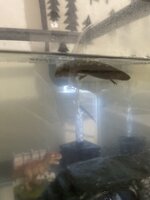Boseph
New member
I purchased my axolotl at an expo and was misinformed about how important the water parameters are so his tank is uncycled I don’t really know what to do at this point I have been testing his tank and keeping an eye on him and the ammonia had been high but I’ve been changing the water often to try to help with that but today once I changed his tank it became really cloudy and he hasn’t been able to keep himself on the bottom of the tank when he swims down as soon as he stops his body starts floating to the top . I need some guidance really on what to do with the cycling of his tank whether it’s possible to do while he’s in it or if I have to do something different while it cycles and maybe the steps on how to do that but I am currently really concerned on how he’s just floating at the top and can’t swim down this hasn’t happened before ,as I am typing this he is swimming more vigorously towards the top now almost like he was mad and is trying to get out please help me I did not do enough research and the expo I bought him from didn’t give me the correct information but I really want him to be happy what can I do as far as the tank levels and him floating near the top


